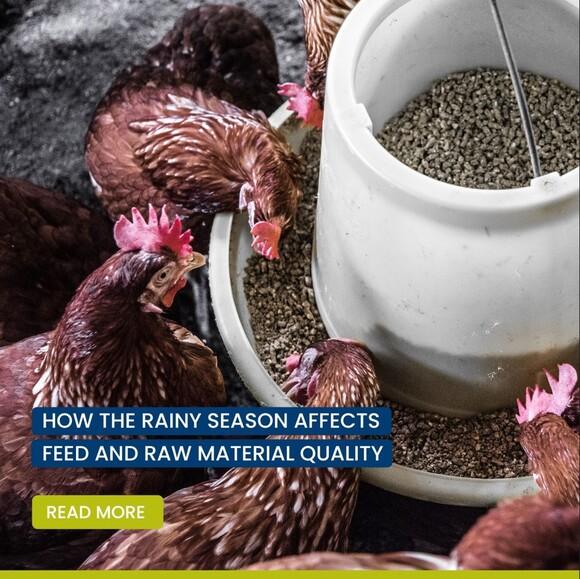Explore all the information on
Feedstuffs
Welcome to the page about Feedstuffs of Engormix; a source of knowledge on Feedstuffs.
I Introduction The development of reduced-crude protein (CP) diets for broiler chickens holds several potential advantages including reduced dependency on imported soybean meal by the Australian chicken-meat industry. Typically, reduced-CP diets contain less soybean meal but more feed grain (and starch) and more synthetic/crystalline amino acids. However, reducing dietary CP from 200 to 150 g/kg in isoenergetic diets has been shown to depress body weight gain, impair food conversion...
Comments : 0
Recommendations: 1
In this episode of Let's Squawk About It, Frank Ivey (Feed2Gain, LLC) talks to Andy Vance (PSA Executive Director) about a type of model used to determine matrix values, and how this model helps understand the impacts of feed changes before they are implemented....
Comments : 7
Recommendations: 8
Professor Ian Godwin’s invited presentation focused on the use of gene editing and genetic modification techniques to improve the protein content and digestibility of sorghum for use in poultry feed. Sorghum is used to produce a range of human food and beverages and is the main summer grain produced in Australia. Sorghum copes well with the unpredictable Australian climate (heat, droughts, floods). Cereals make up more than 60% of poultry feed and sorghum is an excellent feed...
Comments : 0
Recommendations: 0
Soy Connext – the Global U.S. Soy Summit, bringing together 350+ international buyers and sellers of U.S. Soy, is on August 21-23, 2023, at the New York Hilton Midtown in New York City, New York, USA.
The event showcases the best of U.S. Soy, putting a spotlight on solutions delivered through excellent nutrition, quality oil, enhanced profitability, superior sustainability, service, and collaboration. It will be an opportunity to explore insights and trends, and forge new...
Comments : 1
Recommendations: 1
.jpg&w=3840&q=75)

Comprehensive solution in the aninal nutrition industry: Midland ADN Group
Suggested link
Written by: Lacie Dotterweich / AFIA Manager of Communications & Social Media
“If we don’t find overseas markets for our products, many farmers, many producers, go out of business.”
That was the message Daniel Whitley, administrator of the U.S....
Comments : 0
Recommendations: 0
By: Emma Bower, AFIA summer communications intern
Alfalfa is one of the world’s oldest domesticated crops, and today, it is grown on over 20 million acres from coast to coast, making it the nation’s fourth largest acreage crop after corn, soybeans and wheat. The...
Comments : 0
Recommendations: 0
Written by: Lara Moody / IFEEDER Executive Director
Feedstuff production on the farm may be a leading source of the environmental footprint for livestock, poultry, horses and pets, but it doesn’t mean it will be the best solution for reducing it. Regenerative agriculture,...
Comments : 0
Recommendations: 0
Introduction: Gastric ulcerations are a special challenge in modern pork production. Stress can be a reason but in particular the existing milieu conditions have an impact on the development of gastric lesions. The dietetic effects of fibre sources in pigs’ gastrointestinal tract are well known. In some cases fibre sources are used as material for the pigs to root and manipulate. The present study was focused on the amount ingested when fibre sources are offered and...
Comments : 0
Recommendations: 0
.jpg&w=3840&q=75)

Comprehensive solution in the aninal nutrition industry: Midland ADN Group
Suggested link
The Institute for Feed Education and Research's Executive Director Lara Moody recently had the opportunity to moderate a panel exploring the path to sustainable feed. As the agrifood sector seeks opportunities to use feed to reduce the environmental footprint of animal production, the discussion focused...
Comments : 0
Recommendations: 0
Written by: Leah Wilkinson / AFIA Vice President of Public Policy & Education
Some of the best advice I received as a young professional was to hone my skills to make the “elevator pitch” – you know, being able to introduce yourself and share a key point or two all in a...
Comments : 2
Recommendations: 0
Rainwater itself is generally considered clean, but it can pick up bacteria and other contaminants as it interacts with the environment. For example, if rainwater comes into contact with animal feces or contaminated soil, it can potentially carry Enterobacteriaceae bacteria and other pathogens.
Enterobacteriaceae contamination in feed can threaten animal health. Especially high protein materials, such as soy, corn, blood and bone meals are susceptible to harmful pathogens, such as Salmonella,...
Comments : 0
Recommendations: 2
The world is currently experiencing a high cost soybean meal environment, driven by multiple factors including supply-demand disruption due to ongoing transportation congestion, escalating input prices such as fertilizer, as well as supply-demand imbalances due to geopolitical conflicts. Together these factors have pushed soybean meal prices to levels not seen in many years (See Part I). This price pressure has led many feed producers to evaluate the use of non-traditional soybean products...
Comments : 0
Recommendations: 4
.jpg&w=3840&q=75)

Comprehensive solution in the aninal nutrition industry: Midland ADN Group
Suggested link
...
Comments : 1
Recommendations: 0
Tom Weber (AB Vista) mentions the relevance of balance in fiber, in this Swine It interview with host Laura Greiner....
Comments : 6
Recommendations: 4
Feed accounts for more than 65% of poultry production costs; thus, accurate feed formulation is vital to ensure poultry are receiving an optimal diet and nutrients are not in under- or oversupply. However, this is difficult when the nutrient specifications of feed ingredients are highly variable. In order to help reduce this variability, appropriate sampling methodology is critical. Nevertheless, recommended methodology and depth of detail within technical articles varies greatly and does...
Comments : 0
Recommendations: 0
1 INTRODUCTION North America currently imports plant-based feed ingredients, such as soybean meal, from countries that are endemically infected with viruses of economic and pathologic significance to swine including porcine epidemic diarrhoea virus (PEDV), Seneca virus A (SVA), porcine reproductive and respiratory syndrome virus (PRRSV), classical swine fever virus, pseudorabies virus, foot and mouth disease virus (FMDV) and African swine fever virus (ASFV; Blomme et al., 2022;...
Comments : 0
Recommendations: 0
.jpg&w=3840&q=75)

Comprehensive solution in the aninal nutrition industry: Midland ADN Group
Suggested link
Overview Corn is the most common feed ingredient used in poultry nutrition. Maize contributes with up to 65% of the metabolizable energy and 20% of crude protein in poultry diets (Gehring et al., 2013; Dei, 2017). Its average nutritional value is well-known, but it is accepted that the variability in its composition and energy value is a very common issue with great impact on poultry performance and health (Cowieson, 2005; Gehring et al., 2013; Latham et al., 2016;...
Comments : 1
Recommendations: 3
Introduction On August 28, 2021, the United States Department of Agriculture (USDA) confirmed that African swine fever virus (ASFV) had been diagnosed in the Dominican Republic (https://www.aphis.usda.gov/aphis/newsroom/news/sa_by_date/sa-2021/asf-confirm). This poses a tremendous threat to the swine industry of the United States (U.S.) given the proximity to the mainland. When ASFV emerged in China, the virus was able to move rapidly and easily throughout the country due to movement...
Comments : 1
Recommendations: 0
Introduction Monogastric feeds are reliant on plant-based protein sources, like corn and soybean. However, increasing demands on these plant-based materials for non-food industries, such as biofuels, is also associated with an increase in the price of these feed ingredients, placing an impetus on the demand for these alternative protein sources (Leiber et al., 2017). Emerging areas of monogastric animal nutrition research include the use of insect meal, microalgae, single cell...
Comments : 1
Recommendations: 1
Are Your Feeds Safe? This growing season has been a challenge across the upper Midwest. Whether your crops have been hit with drought or hail the odds are that we are going to see an increase potential for feed contaminants such nitrates or molds which cause mycotoxins. This article focuses on mycotoxins and how to manage them. Mycotoxins: Common Questions What is the difference between molds and mycotoxins? Molds...
Comments : 0
Recommendations: 2



.jpg&w=3840&q=75)



















